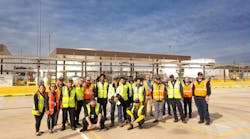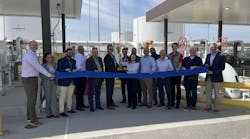Some Southeast Austin residents said their concerns about the location of a planned jet fuel storage facility at Austin-Bergstrom International Airport remain unaddressed.
On Saturday, the airport hosted two in-person community meetings at the airport and one virtual meeting about the facility, which is set to be built on airport property along U.S. 183 between McCall Lane and Metropolis Drive, hundreds of feet from homes and businesses. The meetings featured Spanish language interpreters.
The facility's two tanks will each store 1.5 million gallons of jet fuel.
Amanda Carrillo, who lives on McCall Lane, within walking distance of the planned site, said she has been asking for months whether airport officials considered how the plans would affect residents' quality of life.
She attended both of the in-person meetings.
"But I just feel like they keep giving me the runaround," Carrillo told the American-Statesman after the meetings. "I didn't learn anything new from the meeting. It was all the same. All the talk about is how this is going to be great. But why does it have to be built there, and did they consider us when they planned it?"
The planned above-ground jet fuel storage facility is part of an ongoing expansion at the airport.
Construction of the tanks is set to begin this spring and is expected to be completed within two years.
In October, at least 32 residents signed a petition delivered to the Austin City Council to protest the construction of the facility. At least half a dozen residents told the Statesman they were never notified of the plans to build the facility or given a chance to voice their concerns.
Airport officials, however, said neighbors were notified about the plans to build the jet fuel tank facility most recently in April, as well as in 2017 and 2018 through community meetings, mailings and yard signs.
The community meetings were organized in response to a resolution passed by the City Council in December calling for an environmental study of the site, a list of alternative sites, and improvements in communicating the development plans with residents. The resolution was presented by Council Member Vanessa Fuentes after residents raised quality of life, health and environmental concerns about the proximity of the fuel tank facility to their homes and businesses.
More than 40 people attended the virtual meeting Saturday, including Fuentes and Airport Advisory Commission Chair Eugene Sepulveda.
Some residents stated their opposition to the project via a text chat during the virtual meeting. They also pressed airport officials to offer residents more chances to voice their concerns.
The fuel facility's location was chosen because it met Austin's land development code standards, "is the safest, best fit" and "it doesn't conflict with future airport development, like a third runway, realigned taxiways, cargo operations, general aviation operations, new midfield concourses," Shane Harbinson, deputy chief of planning and development of aviation, said Saturday.
Alternative locations for the jet fuel facility "were evaluated by a third-party engineering firm," which considered sites' environmental impacts; whether alternative sites were already in use or planned to be used for another project; and whether they met Federal Aviation Administration criteria standards, among other concerns, Harbinson said.
Carrillo, 40, who has been advocating for her neighbors on McCall Lane, many of whom are older adults and speak only Spanish, was the only resident of the adjacent neighborhood who attended the in-person meetings. Due to COVID-19 precautions, the in-person meetings required people interested to register online or by calling.
"Some residents had trouble registering for the meeting, and others just aren't familiar with the airport," Carrillo said. "But that's why I am here, and I am going to keep asking questions."
Airport officials told the Statesman on Saturday the meetings were promoted widely through radio ads in English and Spanish, printed in Spanish-language publications and shared on the project's website. Yard signs about the meetings Saturday also were posted on the airport campus and nearby communities, and more than 1,000 invitations in English and Spanish were sent to nearby properties.
The new jet fuel storage facility is needed to meet demand, officials said. As of 2021, the airport had an average daily supply of two to three days of fuel, below the industry standard, which is five to seven days.
"If not built as planned, the airport will have to issue fuel shortage alerts. Airlines will have to carry extra fuel when flying to and from the city of Austin," airport CEO Jacqueline Yaft said in a Saturday news release, "and in some cases, (airport) passengers could experience diversions and canceled or delayed flights."
She said the airport is committed to "balancing our obligation to create safe, modern facilities that exceed customers' expectations while connecting airport-adjacent residents and businesses with the resources and information needed to stay engaged and informed on airport improvements."
Anyone who missed the meeting can watch a recording at SpeakUpAustin.org/AUSFuel.
Austin American-Statesman reporter Natalia Contreras can be reached at 512-626-4036 or [email protected]. Follow her on Twitter and Facebook, @NataliaECG.
©2022 www.statesman.com. Visit statesman.com. Distributed by Tribune Content Agency, LLC.


